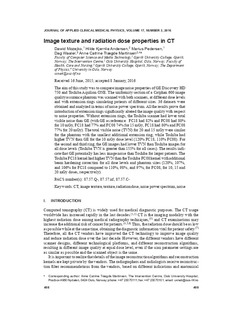| dc.contributor.author | Możejko, Dawid | |
| dc.contributor.author | Andersen, Hilde Kjernlie | |
| dc.contributor.author | Pedersen, Marius | |
| dc.contributor.author | Waaler, Dag | |
| dc.contributor.author | Martinsen, Anne Catrine Trægde | |
| dc.date.accessioned | 2020-03-18T12:29:25Z | |
| dc.date.available | 2020-03-18T12:29:25Z | |
| dc.date.created | 2016-06-28T12:04:16Z | |
| dc.date.issued | 2016 | |
| dc.identifier.citation | Journal of Applied Clinical Medical Physics. 2016, 17 (3), 408-418. | nb_NO |
| dc.identifier.issn | 1526-9914 | |
| dc.identifier.uri | http://hdl.handle.net/11250/2647399 | |
| dc.description.abstract | The aim of this study was to compare image noise properties of GE Discovery HD 750 and Toshiba Aquilion ONE. The uniformity section of a Catphan 600 image quality assurance phantom was scanned with both scanners, at different dose levels and with extension rings simulating patients of different sizes. 36 datasets were obtained and analyzed in terms of noise power spectrum. All the results prove that introduction of extension rings significantly altered the image quality with respect to noise properties. Without extension rings, the Toshiba scanner had lower total visible noise than GE (with GE as reference: FC18 had 82% and FC08 had 80% for 10 mGy, FC18 had 77% and FC08 74% for 15 mGy, FC18 had 80% and FC08 77% for 20 mGy). The total visible noise (TVN) for 20 and 15 mGy were similar for the phantom with the smallest additional extension ring, while Toshiba had higher TVN than GE for the 10 mGy dose level (120% FC18, 110% FC08). For the second and third ring, the GE images had lower TVN than Toshiba images for all dose levels (Toshiba TVN is greater than 155% for all cases). The results indicate that GE potentially has less image noise than Toshiba for larger patients. The Toshiba FC18 kernel had higher TVN than the Toshiba FC08 kernel with additional beam hardening correction for all dose levels and phantom sizes (120%, 107%, and 106% for FC18 compared to 110%, 98%, and 97%, for FC08, for 10, 15 and 20 mGy doses, respectively). | nb_NO |
| dc.language.iso | eng | nb_NO |
| dc.publisher | Wiley for The American Association of Physicists in Medicine | nb_NO |
| dc.relation.uri | http://onlinelibrary.wiley.com/doi/10.1120/jacmp.v17i3.5900/full | |
| dc.rights | Navngivelse 4.0 Internasjonal | * |
| dc.rights.uri | http://creativecommons.org/licenses/by/4.0/deed.no | * |
| dc.title | Image texture and radiation dose properties in CT | nb_NO |
| dc.type | Journal article | nb_NO |
| dc.type | Peer reviewed | nb_NO |
| dc.description.version | publishedVersion | nb_NO |
| dc.source.pagenumber | 408-418 | nb_NO |
| dc.source.volume | 17 | nb_NO |
| dc.source.journal | Journal of Applied Clinical Medical Physics | nb_NO |
| dc.source.issue | 3 | nb_NO |
| dc.identifier.doi | 10.1120/jacmp.v17i3.5900 | |
| dc.identifier.cristin | 1364693 | |
| dc.description.localcode | © 2016 The Authors. This is an open access article under the terms of the Creative Commons Attribution License, which permits use, distribution and reproduction in any medium, provided the original work is properly cited. | nb_NO |
| cristin.unitcode | 194,63,10,0 | |
| cristin.unitcode | 194,65,70,0 | |
| cristin.unitname | Institutt for datateknologi og informatikk | |
| cristin.unitname | Institutt for helsevitenskap Gjøvik | |
| cristin.ispublished | true | |
| cristin.fulltext | original | |
| cristin.qualitycode | 1 | |

